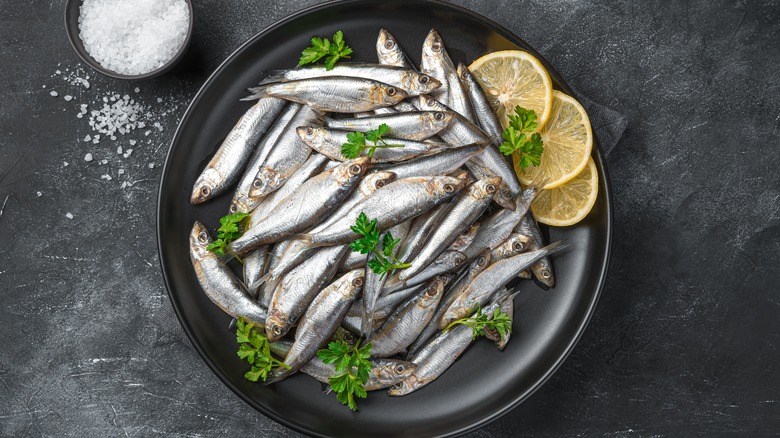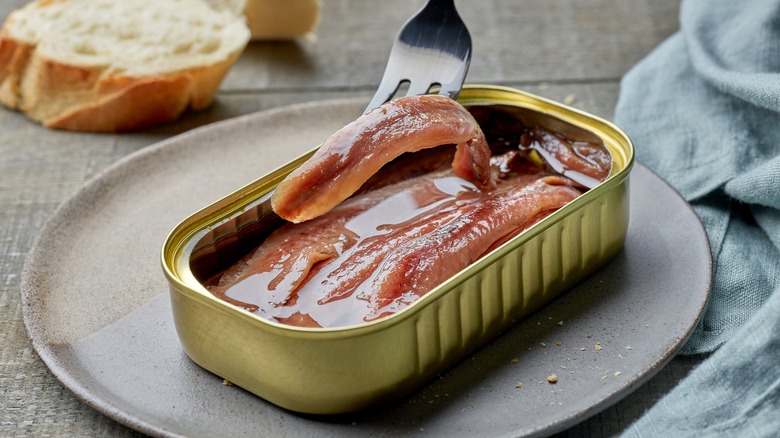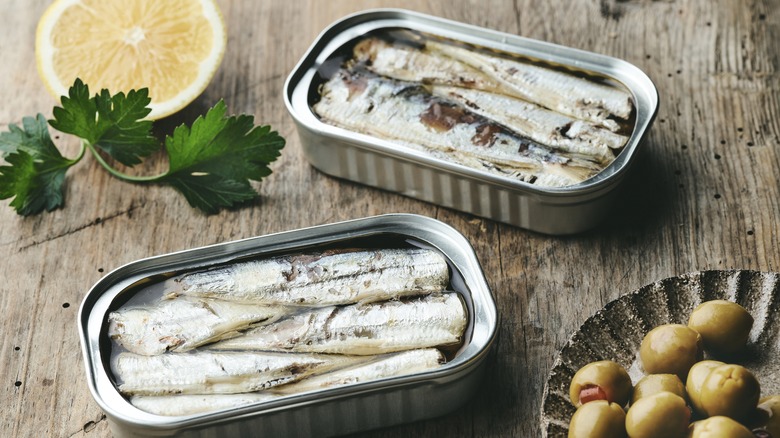Anchovies Vs. Sardines: What's The Difference?
You've probably heard the term "there are more fish in the sea" thrown around as friends encouraged you to look forward to all the other opportunities available to you, whether it be in your romantic life or otherwise. But the key to this phrase is the knowledge that there are, in fact, a ton of fish in the sea, about 32,000 different species to be more exact (via National Geographic). It is remarkable to think about just how deep our oceans are and how much life thrives below the depths. It is impossible to know if we've discovered every kind of fish out there, but we've found quite a few (understatement of the year) and we've found we like eating them quite a bit.
Eating fish is an old culinary concept; ever since humanity found itself near a body of water, it's been dragging its shores to find something to eat. We've taken a liking to carp, salmon, trout, tuna, Arctic char, and even shark! But there are a couple of smaller fish that have gotten a bad rap recently and they are more often than not mistaken for one another. Anchovies and sardines are not the same fish but both have a powerful flavor stuffed inside a very small package.
What are anchovies?
Unless you have an adventurous spirit and palate, odds are you haven't intentionally tried an anchovy. But why? Why do people avoid anchovies like the plague? It's probably due to the smell and flavor. Anchovies are wildly "fishy" and salty in aroma and have a taste that can make them overwhelming. Love Food says that this is compounded by the fact that they are cheaply mass-produced and oversalted which turns people off from the product.
According to A-Z Animals, they are a part of the Engraulidae family native to salt and brackish waters globally. The fish is particularly small, weighing only a few ounces, often eaten whole (bones and all) much like the sardine. The Jopling Globe wants us to know that while anchovies may seem a bit homely and unappetizing today, it is better than the garum which it replaced. Garum was — and there is no polite way to say it — the juices and innards of salted fish. Anchovies replaced them on the shelves as a more appetizing option that gave dishes a powerful briny and fishy flavor. Anchovies are commonly sold as preserved rather than fresh, cured in salt and oils. A little goes a long way with anchovy and you may not have even known you were consuming it but the fish often finds its way into some of our favorite flavor-packed condiments such as Worcestershire sauce (via OU Kosher).
What are sardines?
Ever heard the phrase "packed in like sardines"? It isn't some random little anecdote, it is actually in reference to how sardine fish are stored. They are tiny morsels that have been around for a long time and, according to Healthline, are commonly eaten fresh which is why they are often canned tightly together because they are super perishable.
Like the anchovy, they are not highly sought after by the modern public, but they've been around for a long time. Eating Europe says that they were originally discovered by the Romans when they occupied the area of Lisbon in 19 B.C. and were often consumed as a source of protein and minerals. Today, they are eaten fresh, dried, and cooked in dishes around the world in things like stargazy pie (via Saveur).
Sardines are native to the Pacific and Indian oceans and Britannica says that they are harvested mainly for our consumption, though they are also processed for their oil which can be found in paint or varnish.
Despite common misconceptions, both anchovies and sardines are good eating. Healthline says that though these fish are small, they are mighty when it comes to health benefits. Both fish are packed full of amazing omega-3 fatty acids which help to maintain the health of the body. The only thing to really be concerned about is the high sodium content of canned fish.
How to use them
As for how to eat anchovies and sardines, there are a lot of ways to use them.
They are both "fishy" in flavor, but sardines are considered much less aromatic than anchovies which pack a big punch because they're cured. That being said, Wild Planet Foods suggests using sardines to mix with other ingredients such as mustard, lemon, salt, garlic, or onions to balance out the fishy characteristics and then put them into the main part of your dishes such as rice, salad, or pasta. Anchovies on the other hand are much more pungent and should be added with some caution because they can become overwhelming. Epicurious recommends blending a little bit of anchovy into things like salad dressings and sauces which can then be used on pasta and veggies.
The main difference between the two is that anchovies are usually mixed into a sauce to temper down the pungency and add a little kick whereas sardines are eaten in whole pieces to best enjoy their flavor.
My Recipes says that they are both used in savory dishes, but because of their different pungency levels, anchovies should be used in recipes that need a powerful saltiness whereas sardines can be paired with dishes that require less intense fish-forward flavors.



